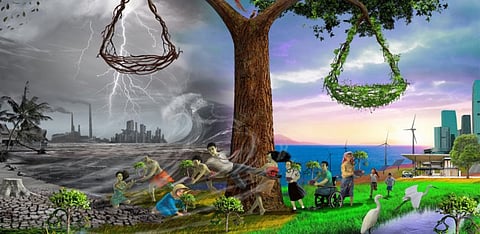

The time for small gestures of care for the planet is long gone. The need of the hour is continuous and deeper citizen engagement with environmental and climate governance in the country.
—–
OVER the past few years, #oneearthonly has become a trending hashtag on social media around this time of the year. But where did this phrase come from? Turns out that the historic United Nations ('UN') Conference on Human Environment took place from June 5 to 16 in Stockholm, Sweden in 1972 with the slogan "Only One Earth".
Today, as we celebrate 50 years of the Stockholm Conference, there's a lot to ponder over how much progress we have achieved in operationalizing the decisions taken during the conference. One of the most important outcomes of the conference was the adoption of the Stockholm Declaration that now forms one of the fundamental soft law sources of international environmental law, with implications for climate policies around the world. Since then, the World Environment Day has been celebrated each year on June 5. Today, the UN recognizes three main threats to the planet – global warming, habitat loss and pollution of natural resources.
In the past week, the UN General Assembly's Stockholm+50 Conference concluded in Sweden with calls for bold actions to accelerate the implementation of the Sustainable Development Goals and the 2030 Agenda. Union Environment Minister, Bhupender Yadav attended the event, reemphasising on the need to bring in climate equity, while planning for a just transition. This is critical for our country as we face climate impacts on one hand, and grapple with competing priorities of poverty alleviation in several dimensions—income, employment and energy, to name a few, on the other. Thus, more than ever, it is clear that we, the people of India, need to engage more with the issue in our daily lives.
Against this backdrop, this World Environment Day, The Leaflet brings to you perspectives from the ground on several such issues. Over the next three days, we explore the challenges facing climate and environmental governance in India as our theme. In this special issue, we have brought together scholars and practitioners in the field of environmental and climate policy discussing topics varying from forest governance to adapting to extreme climate events, from clean energy to air quality to impacts of wildlife protection laws on tribal communities. Connecting all these topics are the two pieces on public consultation and the concept of bandhuta in environmental decision making.
Talking about air pollution and its linkages with climate change and its relevance for India, environmental law scholar Gitanjali Sreedhar takes a critical look at the policies of the Union Government of India to tackle both these issues. Her piece will inform you if India has a robust system to tackle deteriorating air quality as well as reduce its greenhouse gas ('GHG') emissions.
A natural way of dealing with air pollution as well as responding to GHG emissions is to protect our carbon sinks, that is, natural forests. Environmental lawyer and researcher Kanika Sood writes about the current state of forest governance, and she explores the question — whether India can achieve its climate goals with its current system of governance?
Next, read about India's state of policy on climate adaptation, a relevant discussion in light of the extreme heat waves and cyclones in the Bay of Bengal. Lawyer Sharon Mathew analyses whether India is ready to respond to such extreme weather events.
Bringing all this together with the concept of bandhuta, is Utkarsh Jain, an advocate. He rightly points out that the people most impacted by adverse climate change have no access to climate science, and looks at ways affected communities can effectively engage with climate science from a 'dignity-centric' approach. Finally, he connect all this with the larger constitutional scheme in India
Tomorrow, we look at an important facet of India's climate plan — scaling renewable energy generation. At the COP26, India made huge commitments on reaching net carbon neutrality by 2070, scaling non-fossil fuel energy generation capacity to 500 GW by 2030, and depending on renewable energy for half of its energy demands by 2030. I look at the pathways chosen by India in working towards this goal, specifically focusing on the sudden turn in policy to rely on hydropower to reach this goal. Is this sustainable in the long run? Is hydropower really renewable in today's context?
Read about why public consultation is necessary and an integral part of sustainable development in environmental lawyer Mridula Vijairaghavan's piece, in which she delves into the provisions allowing for such consultations as part of environmental decision-making and what has been the government's response to these mandates under law. She explores the concept of the ladder of citizen participation, and explores whether India provides for a 'meaningful' consultation with communities.
Last, but by no means the least, read an excerpt from a book of high relevance on Tuesday —'Criminalisation of Adivasis and the Indian Legal System' written by lawyers Shomona Khanna, Astha Saxena, Puja and Khushboo Pareek. The excerpt provides an overview of the theme of the book— 'discrimination and mass criminalisation'. It delves into a discussion exploring the complexities in the wildlife protection law in India – how its impacts the cultural and traditional way of life of the tribal and forest dwelling communities. I would urge the interested reader to take a deep dive into the book, available here.
The time for small gestures of care for the planet is long gone. The need of the hour is continuous and deeper citizen engagement with environmental and climate governance in the country. I hope this issue makes you, the reader, dwell on the state of governance in our country, and opens your eyes to the myriad challenges facing us today. I also hope that it moves you to be a part of the active citizen movement engaging with elected officers in the government to bridge these gaps and work towards a climate resilient India.